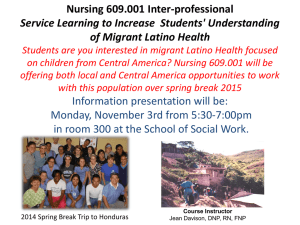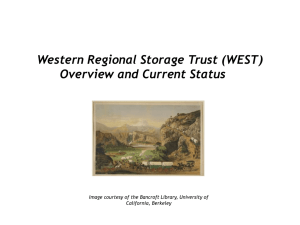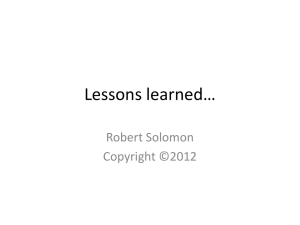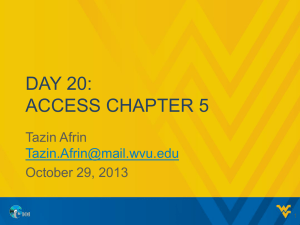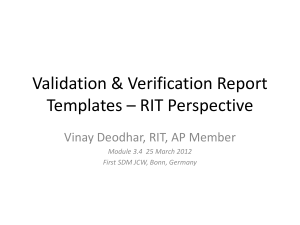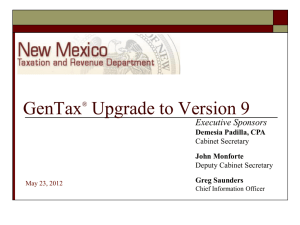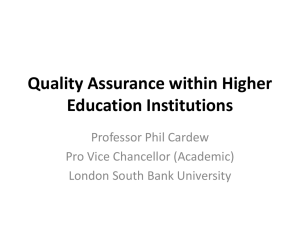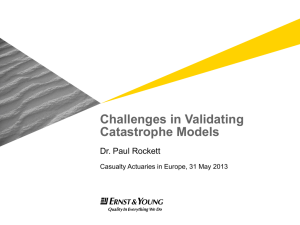TG Webinar: Revisiting Validation Theory: Theoretical Foundations
advertisement
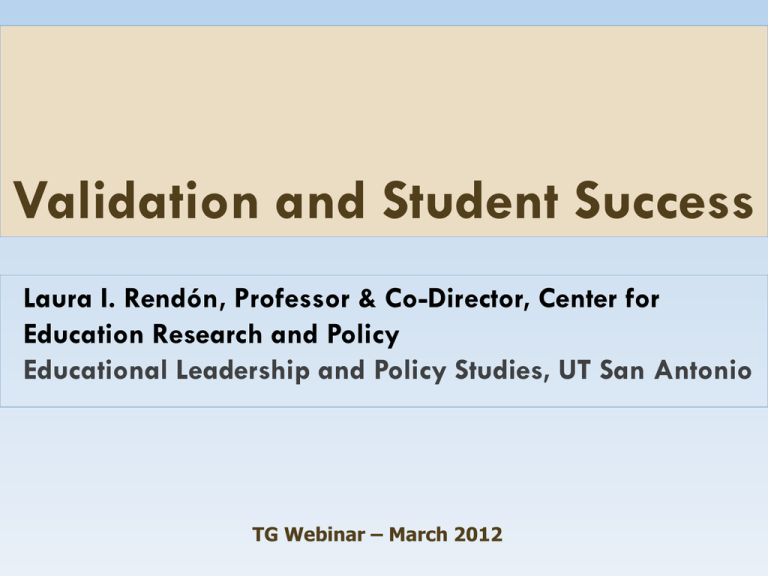
Validation and Student Success Laura I. Rendón, Professor & Co-Director, Center for Education Research and Policy Educational Leadership and Policy Studies, UT San Antonio TG Webinar – March 2012 How I Enter This Work—To Know The Theory is to Know the Theorist Personal Background Origins of Validation Theory National Center for Teaching, Learning and Assessment—Pennsylvania State University __Women’s Ways of Knowing—Belenky, et al., 1984 Who or What Helped You to Graduate from College? Who or What Interfered With You Graduating from College? Differences Between Traditional and Underserved Students Family college-going culture Finances Expectations Congruity between the world of the student and the world of college Differences in ways high schools prepare students to attend college Overall representation in higher education Congruity of College World and World of Middle and Upper Class Students College World • • • • • • • • • Values Traditions Conventions Faculty Curriculum Students World of Middle and Upper Class Students • • • • • Values Traditions Conventions Family Cultural Expectations Worlds are similar Worlds are connected Privileged students face few, if any barriers getting academically and socially integrated in college world Incongruity of College and World of LowIncome, Underserved Students College World • • • • • • • • • • Values Traditions Conventions Faculty Curriculum Students World of Underserved Students • • • • • Values Traditions Conventions Family Cultural Expectations Worlds are dissimilar Worlds are disconnected Underserved students face barriers and transitional problems crossing the academic border When they cross into the college world, they will experience incidents such as: alienation, cultural assaults (i.e., racism, stereotyping, discrimination) Key Points of Inequity Education Achievement Gaps/Points of Inequity High School Graduation Each racial/ethnic cohort had more students graduate in the class of 2008. Yet massive gaps remain. 82.7% of Asian students and 78.4% of white students graduated on time. Only 57.6% of Hispanics, 57% of Black and 53.9% of American Indian students graduated on time–Education Week, 2011. Education Achievement Gaps/Points of Inequity Test Scores. Black and Hispanic students, while doing better on NAEP reading and math assessments in 4th and 8th grades, still continue to trail White students—about 2 grade levels behind in 2009 & 2011. High School Course Taking Patterns. Average number of courses has increased, but White and Asian students twice as likely to take academically rigorous core courses. Fewer than 10% of Black and Hispanic students participated in rigorous courses in 2009. Source: Education Week, 2011 http://www.edweek.org/ew/issues/achievement-gap/ Education Achievement Gaps/Points of Inequity Gender Gaps Only 68% of male students graduated on time in 2008. 75% of female students graduated on time. In the long term, only about 50% of male students from minority backgrounds graduate on time—Education Week, 2011. As of 2010 36% of women ages 25-29 held a BA or better versus only 28% of men in same age group—U.S. Census Bureau, 2011. Men of Color Faring Poorly in K-12 and Undergraduate Ed In large urban centers (NYC, Houston, Oakland, Atlanta, Cleveland and Columbus) minority men graduating high school at rates below 50%. Challenges include: discrimination, misguided perceptions of masculinity, lack of peer and community support, low expectations, absence of academic role models, stigma attached to excelling in education. Espinosa, 2010; Sáenz & Ponjuán, 2012 Black Male Crisis Fewer than 8% of young African American men have graduated from college compared to 17% of Whites and 35% of Asians. Overall, Black males suffer from low college graduation rates, high levels of death, incarceration, and unemployment—Kaiser Family Foundation, 2006; National Urban League, 2007 What’s Happening to Latino Men? Latino males lag behind Latina women in terms of college attendance and degree attainment. Among 18-24 year old Latino males in 2010, 34.2% had not completed high school, compared to 27.1% for Latina females. Sáenz & Ponjuán, 2012 What’s Happening to Latino Men? In 2009 Latina female college enrollment outnumbered that of Latino males by almost 368,000 students. In 2010 less than 40% of college degrees awarded to Hispanics were earned by Latino males. Latinas earned a combined 130,080 of associate or BA degrees in 2009, or 52,713 more than Latino males. Sáenz & Ponjuán, 2012 Leaks in the Educational Pipeline Out of every 100 ninth graders: 68 graduate from high school 40 immediately enter college 27 are still enrolled in their sophomore year Only 18 complete any postsecondary education within 6 years of graduating from high school Source: National Center for Public Policy and Higher Education (2004) 100 Elementary school students 48 Drop out of high school 52 Graduate from high school 20 Attend community college 2 Transfer to a 4-year institution Latino/a Educational Attainment 31 Enroll in college 11 Attend a four-year institution 10 Graduate from college 4 Earn a graduate degree <1 Earns a doctorate Source: Padilla, 2007 Theoretical Frameworks Applicable to Low-Income, First-Generation Students Validation Theory (Rendon, 1994; 2011) ABC Model of Creating Inclusive Environments (Daniel Tatum, 2007) Community Cultural Wealth Model (Yosso, 2005) Funds of Knowledge (Moll, 2001) Liberatory Pedagogy (Frerie, 1971; Rendon, 2009; Hooks, 1994) Ethic of Care (Noddings, 1984; Valenzuela, 1999) Students Want to Know I matter Somebody cares about me I am a capable learner I can be a valuable member of this college community What I bring to the college classroom is as valuable as what others think and know (student voice) The curriculum reflects who I am (inclusive curriculum) What it takes to get into and complete college—a clear pathway toward goal achievement Validation Theory Working with Latino/a Students Validation is an enabling, confirming and supportive process initiated by in- and out-of-class agents that fosters academic and personal development (Rendón, 1994). There are two forms of validation: 1. Academic -- when in- and out-of-class agents take action to assist students to trust their innate capacity to learn and to acquire confidence in being a college student. 2. Interpersonal -- when in- and out-of-class agents take action to foster students’ personal development and social adjustment ADMINISTERING VALIDATION Validation, when it is administered early in the student’s transition to college, and consistently throughout the college experience, may be the key to helping students get involved and believing they can learn and achieve their goals. Out-of-Class Validating Agents Spouse, Boyfriend, Girlfriend Family: Parents, Siblings, Relatives, Children Friends: Classmates, College Friends, Non-College Friends College Staff: Faculty, Coaches, Counselors, Advisors, Tutors, Teaching Assistants, Resident Advisors In-Class Validating Agents Faculty Coaches Lab Instructors Teaching Assistants The Puente (Bridge) Project As A Validating Learning Community Community College Puente Model English Classroom • Reading Skills • Writing Skills • Research Skills Counselor Mentor • In English Classroom • Develops Education Plan • Community Member • Give Back to Community Validating Agent: Barbara Jaffee Associate Dean, Humanities—El Camino College, California Professor of English and ESL—El Camino College, California Barbara Jaffey, English Professor, El Camino College Academic Validation in English Classroom Affirm real possibility students can be successful college students—bring speakers to class that resemble characteristics of students; allow students to see themselves in what they are learning Provide opportunities for students to witness themselves as capable learners—research papers call for high levels of critical thinking skills and writing ability. Students submit papers knowing they can meet these requirements. Academic Validation in English Classroom Affirm value of personal voice in the classroom— knowledge can initiate from student personal experience; writing assignments include essays about how students got their names; research papers on topics rooted in the student personal experience. Create a familia learning atmosphere—students organize into familias for essay or topic discussions. These evolve into study groups outside the classroom. Impact of Validation—Not About “Coddling Students” Believe “I can do it” Believe in inherent capacity to learn Become excited about learning Feel a part of the learning community Become motivated or driven Feel cared about as a person, not just a student Students in the Puente Project at El Camino College, CA Daniela Issis Vanessa VALIDATION THEORY: ROLE OF ADVISERS TG Webinar – March 2012 Validating Underserved Students: Best Practices for Advisers Build a relationship with students. • Ask questions about their life, struggles they have been through. • Emphasize the importance of education for their families. Do not assume all students know how to get involved and how to access campus information. Advisors should take the first step in reaching out to assist students and helping them to get involved in campus life. Whenever possible, affirm students as being capable of collegelevel work. Indicate to students that what they know and the backgrounds they bring are as important as what others know and bring to college. Validating Underserved Students: Best Practices for Advisers Call students by name. Be friendly, accessible, supportive and helpful. Praise student success. Introduce student to other students in similar situations. Encourage students to validate and support each other (i.e., students provide positive reinforcement, form friendships, serve as peer support network). Assumptions of Validation Theory Works with students as whole human beings. Attention to intellectual, social, emotional and innerlife aspects of human development. Is asset-based (as opposed to deficit-based). Rooted in the experiences of low-income, firstgeneration students. Works to promote equitable outcomes and to promote inclusive classrooms Makes students academically and personally stronger Shifts role of institution from passive to active Improve Access, Experience & Completion Access • College Ready P-20 Initiatives • Recruitment • Advising • Financial Aid • College Transition • _____________________ • Validating Actions: • Affirm students as capable of college • Provide support and encouragement to attend college Student Experience • Faculty and Staff Development • Teaching/Learning • Advising & Counseling • Engagement • Learning Communities • Service Learning • Contemplative Pedagogy • ____________________ • Validating Actions: • Inclusive curriculum rooted in student experiences • Assist students to view selves as capable college students • Encourage study group where students validate each other Completion • Graduate School Ready • Workforce Ready • GPA • Certificates, Degrees • College Completion Seminars To Know the Theory is to Know the Theorist “What is going to be my legacy?...Clearly, what I think I will be remembered for is that I made a difference in the lives of people who grew up just like me having no hope, and I made a difference in folks thinking about the world in a much more connected, humanistic, holistic way…The essence of both of those things is love…(Rendon, quoted in Osei-Kofi, 2011)” Validation Theory: Key References Rendon, LI (1994) Validating culturally diverse students: Linares-Rendon, LI & Munoz, S. (2011) Special issue of Enrollment Management Journal Rendon, LI (2002). Community college Puente: A validating model of education. Educational policy. Vol 16, 4, 642-667
